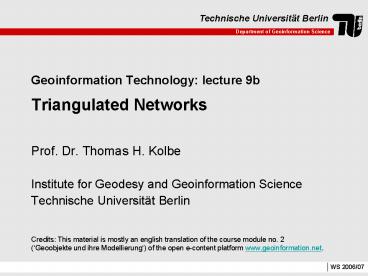Geoinformation Technology: lecture 9b Triangulated Networks - PowerPoint PPT Presentation
1 / 10
Title:
Geoinformation Technology: lecture 9b Triangulated Networks
Description:
diffluent edges form. water sheds. transfluent. confluent: direction of. water drain. diffluent: border of a catchment area. WS 2006/07. 10 ... – PowerPoint PPT presentation
Number of Views:65
Avg rating:3.0/5.0
Title: Geoinformation Technology: lecture 9b Triangulated Networks
1
Geoinformation Technology lecture 9b
Triangulated Networks
- Prof. Dr. Thomas H. Kolbe
- Institute for Geodesy and Geoinformation Science
- Technische Universität Berlin
Credits This material is mostly an english
translation of the course module no. 2
(Geoobjekte und ihre Modellierung) of the open
e-content platform www.geoinformation.net.
2
Excursion Voronoi Diagrams
- Given a set M of n points in a plane
- The Voronoi diagram of the point set divides the
plane into n disjoint areas (Voronoi regions). - The Voronoi region of one point p contains
exactly one of the points of M as well as all
points q, which lie closer to p than to every
other point p?M with p?p (areas of same
nearest neighbours).
3
Voronoi Diagram Delaunay Triangulation
- the Voronoi diagram immediately provides the
Delaunay triangulation - connect the nodes of neighbouring faces by
(yellow) edges - the yellow edges constitute the wanted Delaunay
TIN - note the yellow Delaunay edges stand
perpendicularly on the dashed Voronoi edges - the Delaunay triangulation is the dual graph of
the Voronoi diagram
4
TINs with Break Lines
- problem The edges of topographic objects should
be considered within the triangulation - aim break lines are aggregations of triangle
edges - inserting break lines leads to a finer triangle
structure - In general, this triangulation does not fulfill
the Delaunay criterion
5
Constrained Delaunay Triangulation
- Visibility of points
- P is visible from Q, if the straight connection
PQ does not intersects a break line. - The constrained circle criterion
- no visible fourth node lies in the perimeter of a
triangle - Constrained Delaunay triangulations fulfill the
constrained circle criterion - This criterion provides an algorithm for the
insertion of break lines to a (constrained)
Delaunay triangulation (? exercise).
6
Triangulated Networks - Example Siebengebirge
Rhineriver
Bonn
7
Traingulated Networks - Example Siebengebirge
8
Application Example for TINs
- Analysis of differences in height (water flow)
leads to 3 edge types - transfluent edge water flows from neighbouring
triangle over the edge away - confluent edge (drain) water from at least one
triangle flows off along the edge - diffluent edge (watershed) neither diffluent nor
confluent
9
Simple Drainage Model
- simplifying assumption the earth's surface is
impermeable - confluent edges form the hydrography
- diffluent edges form water sheds
transfluent
diffluent border of a catchment area
confluent direction of water drain
10
Triangle networks Literature
- Lenk, Ulrich 2.5D-GIS und Geobasisdaten-Integrat
ion von Höheninformationen und Digitalen
Situationsmodellen. PhD thesis, Institute
for Photogrammetry and Geoinformation,
University of Hannover, 2001 - Worboys, Michael F. GIS A Computing
Perspective. Taylor Francis Inc., London
1995































